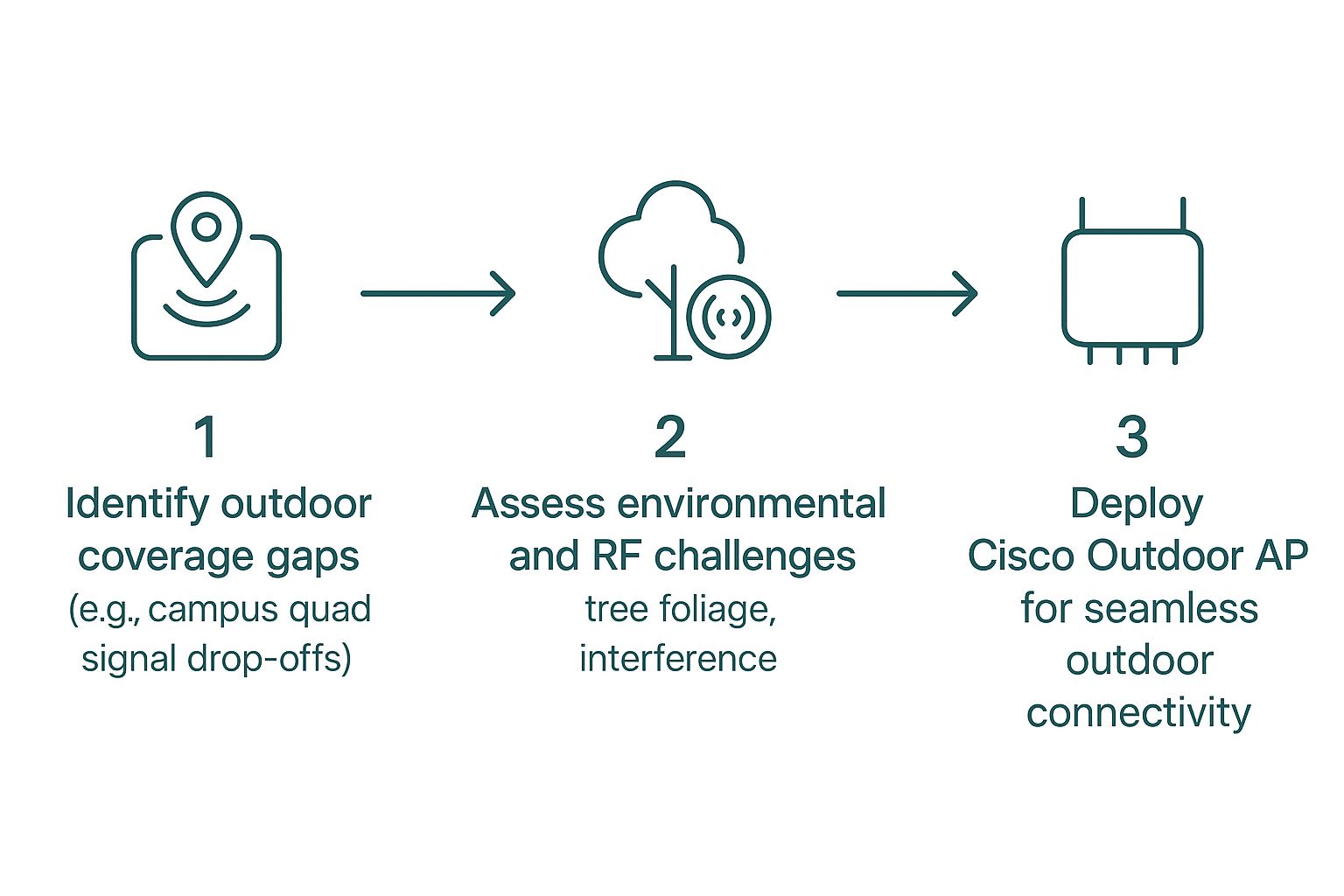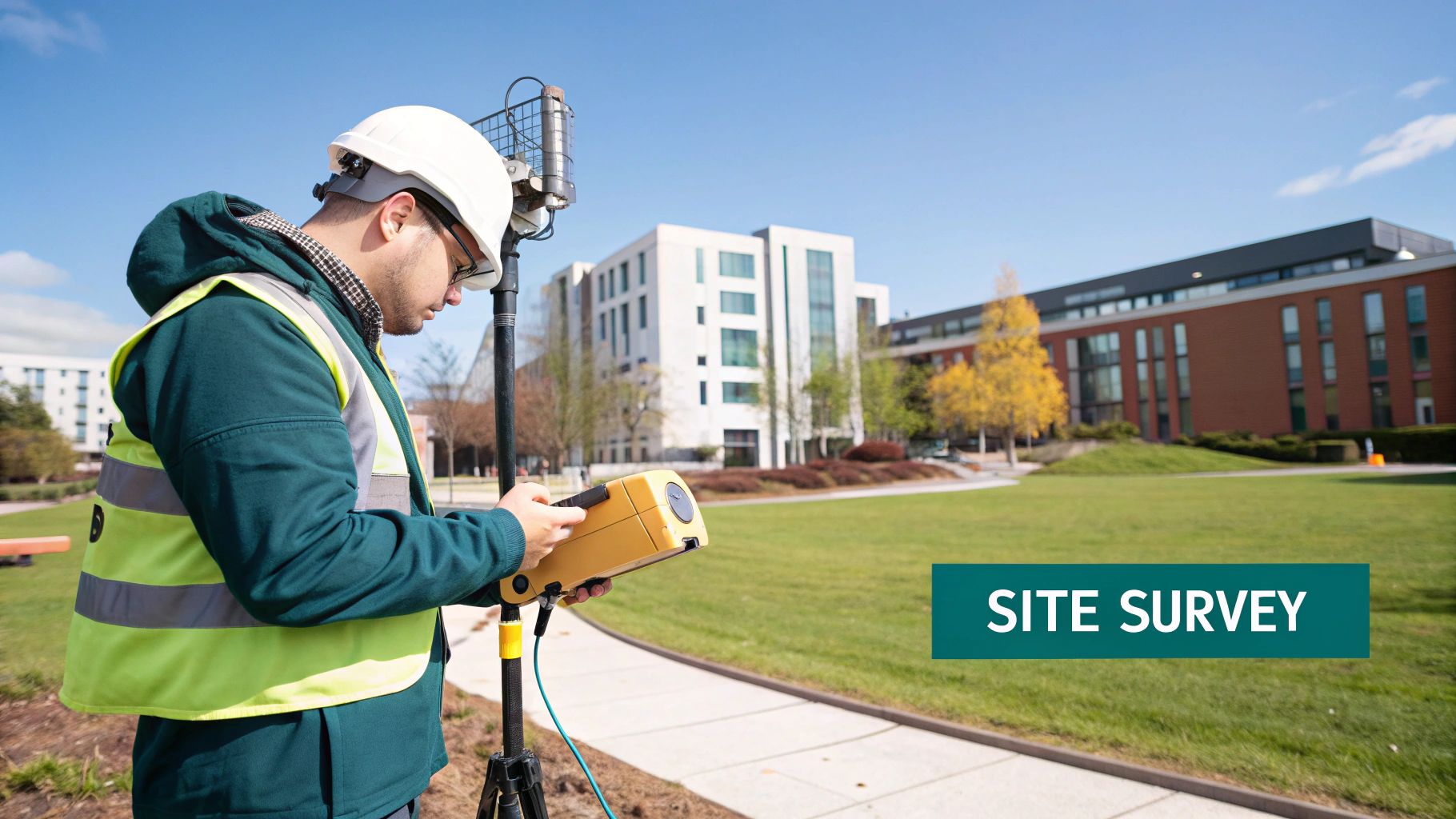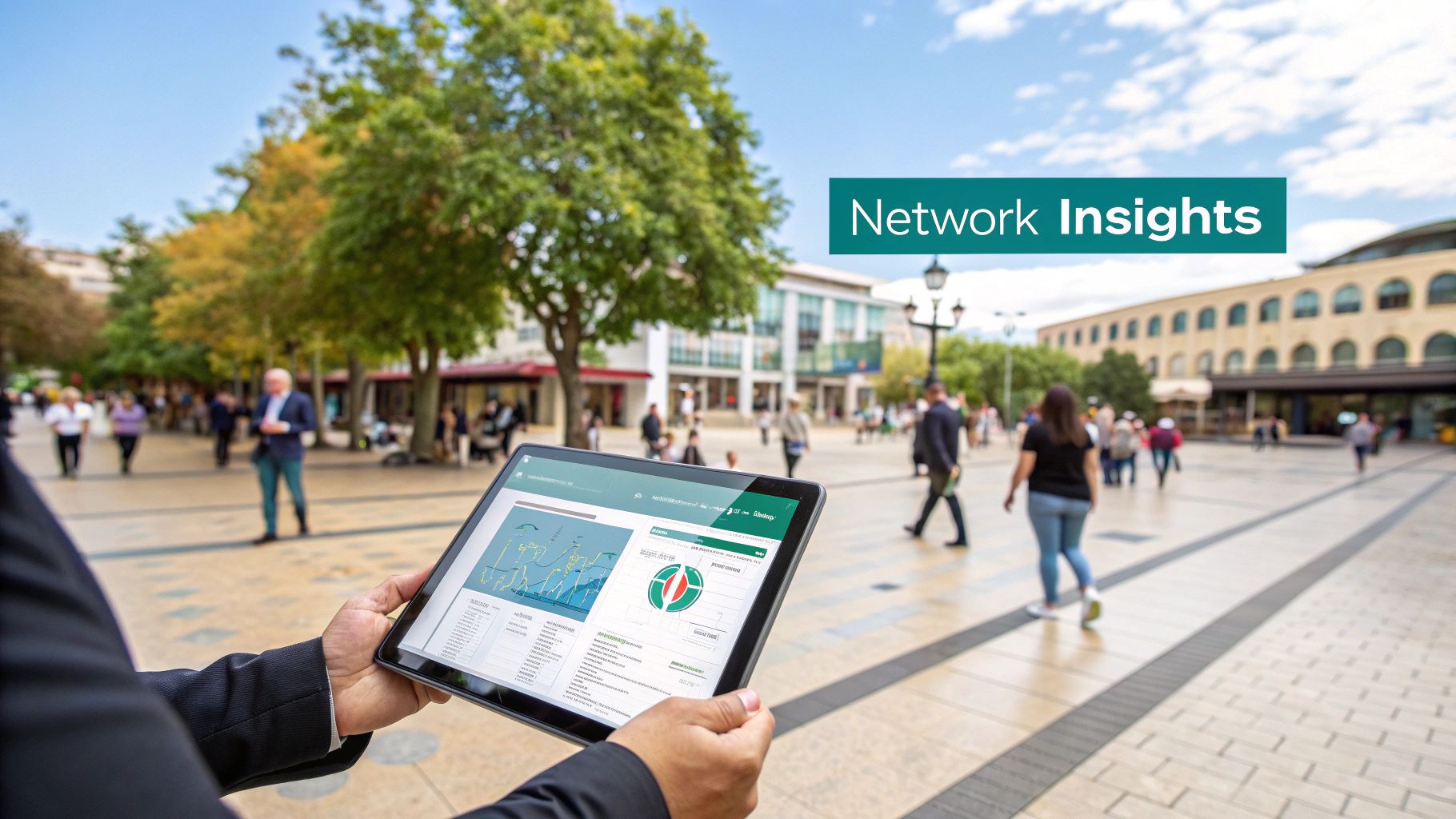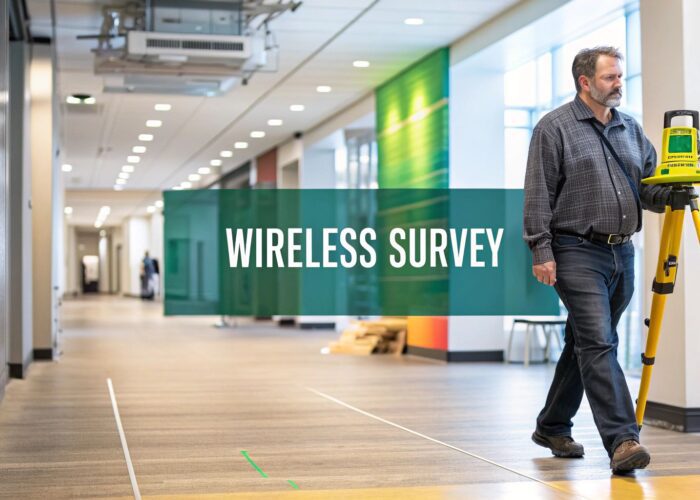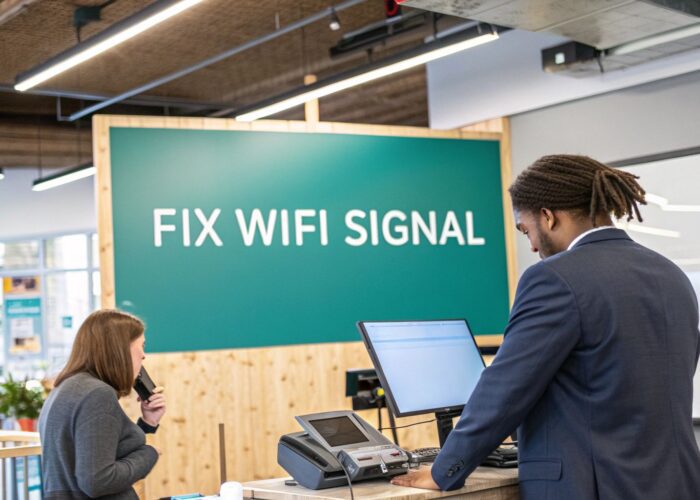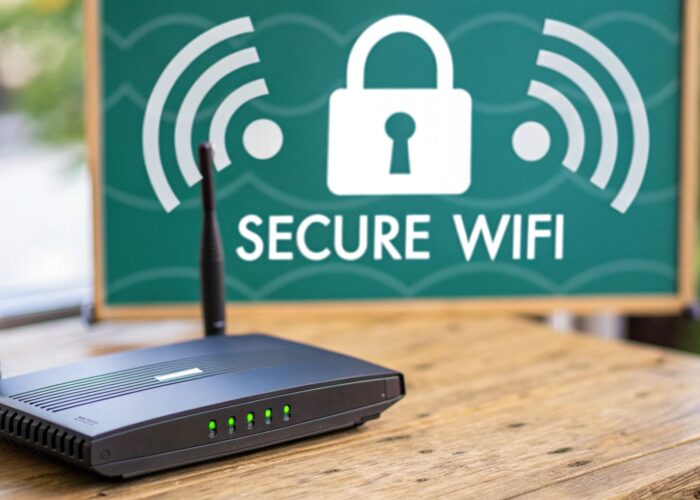A reliable Wi-Fi signal shouldn't just stop at your building's door. Whether you're managing a bustling retail plaza, a sprawling university campus, or a modern corporate park, extending your network outdoors is no longer a luxury—it's an expectation. Let's talk about how a Cisco outdoor AP can make that happen. These rugged devices, including the incredibly popular cloud-managed Cisco Meraki line, are specifically engineered to deliver robust, high-performance connectivity in the most challenging open-air environments.
They are built from the ground up to withstand the elements while providing the kind of seamless user experience people are used to indoors. It's a game-changer.
Why Your Network Needs to Go Outdoors
Have you ever tried to stretch the signal from an indoor access point to cover an outdoor patio? It's a classic recipe for dropped connections and, eventually, fried hardware. Standard APs simply aren't built to handle rain, dust, extreme temperatures, or the unique radio frequency (RF) challenges found in wide-open spaces. That’s why a purpose-built outdoor solution isn't just a good idea—it's essential for a reliable network.
Taking your Wi-Fi outside opens up a ton of new opportunities for engagement, operations, and productivity. It's about more than just broadcasting a signal; it’s about creating connected experiences where people actually spend their time. For instance, as more venues are designing an inviting outdoor living space, planning for reliable Wi-Fi has become a core part of the architectural process itself.
Connecting Key Sectors
Let’s look at a few real-world scenarios where a Cisco outdoor AP makes a massive difference, especially in key sectors like Education, Retail, and corporate BYOD environments:
- Education: For a university, outdoor Wi-Fi means students can study on the quad, collaborate on projects between classes, and stay connected across a huge campus without a single hiccup. It's all about extending the learning environment beyond the classroom walls.
- Retail: A shopping center can blanket its outdoor plazas with guest Wi-Fi, using a captive portal to gather valuable customer data and enhance the visitor experience. It turns a simple amenity into a powerful marketing tool.
- BYOD Corporate: A corporate campus with outdoor seating allows employees to take meetings outside, fostering a more flexible and dynamic work culture. With secure authentication solutions like IPSK or EasyPSK, you can ensure every Bring-Your-Own-Device connection is completely safe and managed.
The infographic below breaks down the simple, strategic process for taking your network into the great outdoors.
As you can see, a successful deployment always starts with understanding your unique environment. Only then can you choose the right hardware to overcome its specific challenges.
Market Leadership and Proven Success
Cisco's dominance in this space is no accident; it's built on a foundation of powerful, reliable technology. The company holds a commanding 37.1% share of the global industrial and outdoor wireless market, a figure that jumps to an incredible 52.1% in North America.
This leadership is driven by advanced hardware that supports the latest standards like Wi-Fi 6E, which is crucial for handling high-density environments. This focus allows Cisco and Meraki to deliver rock-solid connectivity for everything from automated manufacturing floors to complex port operations.
Laying the Groundwork for a Killer Outdoor Wi-Fi Network
A high-performance outdoor network doesn’t just happen when you bolt a Cisco outdoor AP to a pole. It’s born from meticulous planning and a rock-solid strategy. If you skip this groundwork, you're essentially building a house without a foundation, and you’re just asking for trouble down the line.
Let's walk through the essential pre-deployment steps that make the difference between a network that just works and one that’s a constant headache.
First things first: the outdoor site survey. This isn't optional; it's absolutely critical. Unlike an office with predictable walls, the great outdoors is a wild and unpredictable environment for Wi-Fi signals. You're up against constantly shifting challenges.
Think about it—trees with thick leaves can soak up your signal, especially during the summer. Different building materials like brick, concrete, or metal siding can reflect or completely block radio waves in ways you’d never expect. A professional survey helps you map all of this out before you even think about running a cable.
If you want to go deeper, our guide on how to perform a comprehensive site survey for a wireless network is an excellent resource to have in your back pocket.
Choosing the Right Cisco or Meraki AP
Once you have that crucial site survey data, you can start matching the right hardware to your specific environment. Both Cisco and Meraki have a fantastic lineup of outdoor access points, but picking the right model is everything. It all comes down to what you're trying to achieve.
- Covering a Big Area? If you're lighting up a large, open space like a university quad or a shopping plaza, an AP with omnidirectional antennas is your best bet. It broadcasts a signal in a 360-degree pattern to cover the whole zone.
- Connecting Two Buildings? Need to bridge a connection across a parking lot without digging trenches for fiber? A directional AP creates a powerful, focused wireless link over long distances, giving you a surprisingly reliable connection.
- Expecting Huge Crowds? For places like outdoor stadiums or concert venues, you need to plan for thousands of people trying to connect at once. A high-density AP is built for this exact scenario, handling that massive client load without even breaking a sweat.
It's just like using the right tool for the job. You wouldn't use a hammer to drive a screw. Selecting the correct Cisco outdoor AP from the start is what guarantees you'll get the performance and reliability you're paying for.
One of the most common mistakes I see is underestimating RF interference from neighboring wireless networks, especially in dense urban areas. A proper site survey will sniff out those competing signals, which allows you to strategically select channels and AP placements to sidestep the noise and maximize your network's performance.
Getting Power and Mounting Right
How you power and mount your APs is just as important as where you put them. The vast majority of modern outdoor setups rely on Power over Ethernet (PoE), and for good reason—it’s a total game-changer. It sends both data and electricity over a single Ethernet cable, which makes installation incredibly simple.
Just be aware that today's powerful APs often demand PoE+ or even PoE++, so double-check that your network switch can deliver the required wattage.
Proper mounting is all about longevity and performance. Always install the AP according to the manufacturer's guidelines. This ensures its weather-sealed enclosure (usually with an IP67 rating) can do its job and protect the sensitive electronics from rain, dust, and wild temperature swings. A secure mount also keeps the AP from shifting over time, which could easily mess up your carefully planned coverage and create frustrating dead zones.
Ultimately, this simple blueprint—survey, select, and secure—is your roadmap to a successful deployment. Taking the time to plan upfront ensures your investment in Cisco or Meraki hardware delivers a robust and reliable outdoor Wi-Fi experience for everyone, whether it’s for an Education campus, a Retail center, or a corporate BYOD environment. This solid foundation is also what preps your network for a seamless integration with Captive Portals and advanced Authentication Solutions like IPSK and EasyPSK.
Crafting the Perfect Wi-Fi Welcome with Captive Portals
The moment a user connects to your outdoor network is your first, and often best, chance to make a solid impression. Let's be honest, a generic password prompt just doesn't cut it anymore. That initial interaction sets the tone, and this is where a well-designed captive portal, running on your Cisco outdoor AP infrastructure, really makes a difference.
A modern captive portal is so much more than a simple login screen. Think of it as the digital handshake between you and your guests—a powerful tool for branding, security, and engagement.
Picture a sprawling university campus where students and staff use their existing school IDs for seamless, secure Wi-Fi access on the quad. Or imagine a retail plaza that offers free connectivity in exchange for an email signup, turning a public amenity into a fantastic marketing channel. This is the kind of power you unlock when you pair robust Cisco Meraki hardware with a sophisticated portal solution.
Transforming the Login Experience Across Sectors
The real beauty of a modern captive portal is its flexibility. You can create completely different onboarding journeys depending on who is connecting and where they are, all while managing it from one place. The Meraki dashboard, in particular, makes it incredibly easy to integrate with third-party platforms like Splash Access. This lets you move beyond a basic splash page and build something genuinely special.
Here’s how this plays out in the real world:
- Education Campuses: A university can roll out a portal that bleeds school spirit, offers quick links to event schedules, and authenticates users against existing student credentials. It creates a secure, branded experience whether someone is in the library or studying on the main lawn.
- Retail and Hospitality: An outdoor shopping center can present guests with a slick, beautifully designed portal offering one-click social media logins. In exchange for access, the business can capture valuable demographic data, push targeted promotions, or grow its newsletter list.
- Corporate BYOD Environments: For a corporate campus with outdoor workspaces, the captive portal becomes a crucial security checkpoint. Before granting access, you can require employees to accept the company's acceptable use policy or use secure authentication solutions to get their personal devices (BYOD) onboarded safely.
This level of customization is what turns a simple Wi-Fi login into a strategic asset. If you're just starting to explore the possibilities, digging into the fundamentals of a modern Wi-Fi captive portal is a great way to get ideas for your own projects.
More Than Just a Pretty Face
While a great design gets users in the door, the true value of an advanced captive portal lies in its security and data capabilities. You’re not just providing internet; you're creating a managed and secure entry point to your network. This is where more advanced authentication methods become essential.
The real magic happens when you pair a captive portal with robust authentication. You move from a simple, open guest network to a controlled environment where you know who is connecting, when, and from where. This is a game-changer for security and network management.
For instance, you can implement tiered access levels. A casual guest in a retail center might get a limited amount of bandwidth for a couple of hours, while a registered VIP customer could receive a faster, all-day connection. In a corporate BYOD setting, this means you can easily integrate with methods like IPSK or EasyPSK to ensure every personal device is securely onboarded with its own unique credential.
This granular control is all managed through the portal's direct interaction with the Cisco Meraki cloud. When a user authenticates, the portal service tells your network infrastructure exactly which policies to apply to that specific user's device, all in real-time. The entire process is seamless for the end-user but gives you an incredible amount of control on the back end. It's a smart, secure, and user-friendly way to welcome everyone to your outdoor network.
Implementing Rock-Solid Authentication
You’ve got a beautiful, branded welcome mat for your network with a captive portal. So, what’s next? A great first impression is important, but robust security is absolutely non-negotiable. This is where we shift from just connecting users to thinking about how we connect them securely and efficiently on your Cisco outdoor AP network.
Let's be honest, the old model of a single, shared Wi-Fi password for everyone is a security nightmare waiting to happen. One compromised device or disgruntled employee can put your entire network at risk. And changing it? That's a massive headache that involves updating every single connected device.
Thankfully, modern authentication has completely solved this problem, and these solutions work beautifully with both Cisco and Meraki hardware.
Moving Beyond the Single Password
The real game-changer in secure Wi-Fi access is a technology called Identity Pre-Shared Key, or as most of us in the field call it, IPSK. Think of it as giving every single user or device its own unique key to the network. This simple shift has massive benefits, especially for busy outdoor environments.
I've seen it work wonders in a few key settings:
- BYOD Corporate: Picture a corporate campus with outdoor seating areas. With IPSK, every employee’s personal laptop and phone (BYOD) gets its own key. When an employee leaves, you just revoke their key. No mass password change, no disruption for anyone else.
- Education: On a university campus, you can issue an individual password to each student for the entire semester. If a student loses their device or violates a usage policy, an admin can instantly cut off its access without disrupting thousands of other users.
- Retail: A large retail center could provide premium, high-speed Wi-Fi to its tenants and staff using IPSK, while still offering a separate, open guest network through the captive portal.
This level of granular control is a massive leap forward for network management. It simplifies onboarding, dramatically improves your security posture, and makes troubleshooting so much easier because you can trace network activity back to a specific user or device.
The Power of IPSK and EasyPSK
Solutions like IPSK and EasyPSK plug directly into your network infrastructure, typically using a RADIUS server on the backend to manage all those unique keys. When a user tries to connect, their unique credential is checked against the server. If it's valid, they’re granted access with the right permissions. It's that clean.
If you want to get into the technical nitty-gritty, you can explore the mechanics of IPSK with RADIUS authentication to see how all the pieces fit together.
The demand for these secure, high-performance outdoor networks is exploding. The global outdoor Wi-Fi access point market has already hit an estimated USD 5.2 billion. This growth is being driven by smart city projects and the increasing need for reliable connectivity in public spaces. You can discover more insights about the outdoor Wi-Fi market trends on dataintelo.com.
Comparing Your Authentication Options
Choosing the right authentication method really comes down to your goals for security, user convenience, and how much time you want to spend managing it all. A simple open network might be fine for a small pop-up event, but a university campus requires something far more robust.
The goal is to find the perfect balance. You want security that is strong enough to protect your network and your users, but not so complicated that it creates a frustrating experience. For most organizations, IPSK hits that sweet spot perfectly.
Let's break down the most common methods you’ll encounter when setting up your Cisco outdoor AP network.
Comparing Modern Wi-Fi Authentication Methods
Here's a quick look at different authentication methods to help you choose the right level of security and convenience for your Cisco outdoor network.
| Authentication Method | Best For | Security Level | User Experience |
|---|---|---|---|
| Open Network | Quick, temporary guest access where security isn't a primary concern. | Low | Extremely simple; users just connect without any password. |
| Single PSK (WPA2) | Basic protection for small, trusted groups where convenience is key. | Medium | Simple; everyone uses the same shared password to connect. |
| Captive Portal | Public guest networks in retail or hospitality for data capture and branding. | Varies | Interactive; users log in via a web page with email, social media, or a form. |
| IPSK / EasyPSK | Corporate BYOD, education, and multi-tenant environments needing high security. | High | Secure & simple; each user or device has a unique, manageable password. |
By choosing the right authentication strategy, you're not just locking down your network against unauthorized access; you're creating a seamless and manageable experience for everyone. It's the final piece of the puzzle that turns your powerful outdoor hardware into a truly smart, secure, and user-friendly wireless solution.
Managing Your Network From a Single Dashboard
Once your Cisco outdoor AP network is physically installed and configured, the real work—and fun—begins. You get to step back and manage the entire system from a single command center: the Cisco Meraki dashboard. This is where you shift from deployment to day-to-day operations, and thankfully, it’s an incredibly intuitive experience.
Think of this cloud-based platform as the heart of your outdoor wireless network. It gives you a bird's-eye view of everything happening in real-time. It’s built to be simple enough for a small coffee shop owner but deep enough for a university IT department managing hundreds of APs across a sprawling campus. The goal is to make complex network management feel effortless.
Proactive Monitoring and Health Checks
One of the biggest wins with the Meraki dashboard is its proactive approach to network health. Instead of waiting for a user to complain about a slow connection, you can spot potential issues long before they impact anyone. The dashboard gives you a clean, color-coded summary of your entire network, including all your outdoor APs.
You can instantly see which APs are online, how many clients are connected to each, and what their performance looks like. If an AP in a high-traffic area—say, a student quad or a busy retail plaza—suddenly drops offline, you’ll get an alert immediately. This lets you jump into troubleshooting right away, often before anyone even notices a problem.
The platform's strength is a big reason for Cisco's market leadership. The enterprise WLAN segment, which includes these powerful outdoor access points, saw revenues hit USD 904.5 million in just the first quarter, a 4.6% year-over-year jump. This growth is fueled by the exact kind of cloud-based management that simplifies deploying and maintaining complex networks. You can explore more wireless market insights from the Business Research Company to get the full picture.
Optimizing Performance With Smart Tools
Beyond just watching for problems, the dashboard gives you a whole suite of tools to actively fine-tune your network's performance. This isn't about "set it and forget it"; it's about continuously improving the user experience based on what’s actually happening out in the field.
Here are a few pro tips I always recommend for getting the most out of it:
- Visualize Your Coverage: Use the built-in heatmaps. Upload a floor plan or a satellite map of your outdoor space, and the dashboard will overlay a visual map of your Wi-Fi signal strength. You’ll instantly see where coverage is strong and, more importantly, where you might have dead zones.
- Manage Bandwidth Intelligently: In a corporate BYOD environment, you can set traffic-shaping rules to prioritize business-critical apps (like video conferencing) over social media. For a public guest network, you could cap the bandwidth for each user to ensure a fair and consistent experience for everyone.
- Configure RF Profiles: The dashboard automatically analyzes the radio frequency (RF) environment around your Cisco outdoor AP fleet and assigns the best channels to minimize interference. This is an absolute lifesaver in dense urban areas where you’re competing with dozens of other Wi-Fi networks.
The real power of the Meraki dashboard is that it turns raw network data into actionable insights. You’re no longer just looking at numbers; you’re seeing a story about how people are using your space, which is incredibly valuable.
Turning Your Network Into a Strategic Asset
Maybe the most exciting part of managing your network from the dashboard is what you can do with its rich analytics. Your Wi-Fi network is constantly gathering data, and these insights can be a goldmine for making smarter business decisions, especially in the Retail and Education sectors.
For example, a retail center can use location analytics to track foot traffic patterns through an outdoor plaza. You can see which storefronts get the most visitors and at what times—invaluable information for leasing decisions and event planning. A university can do something similar, analyzing peak usage times on campus to better allocate resources, like adding more seating or power outlets in popular outdoor study spots.
This is the ultimate goal of a modern wireless network. It’s not just about providing internet access. It’s about creating a smart, strategic asset that helps you better understand your environment and serve your users—all managed effortlessly from a single, friendly dashboard.
Common Questions About Outdoor Wi-Fi Deployments
When you're planning an outdoor Wi-Fi project, a handful of questions almost always come up. We hear them all the time from teams in Education, Retail, and corporate settings setting up BYOD networks. Whether you're working with a Cisco outdoor AP or a cloud-managed Meraki device, getting the fundamentals right is everything.
Let's walk through some of the most common queries and clear things up.
Can I Just Use an Indoor AP Outside to Save Money?
I get why people ask this—it seems like an easy way to cut costs. But the answer is a hard no. It's a classic shortcut that will end up costing you more in the long run.
Cisco outdoor APs are purpose-built machines. They come in rugged, IP-rated enclosures (like IP67) that are fully sealed to protect against rain, dust, and extreme temperatures. An indoor AP simply has none of this armor. Put one outside, and it's only a matter of weeks or months before it fails, voiding the warranty and creating a massive network headache.
Plus, their internal antenna designs are all wrong for the outdoors. They're designed for signals to bounce off interior walls, not to broadcast clearly across wide, open spaces filled with interference.
What's the Real Difference Between IPSK and a Regular Wi-Fi Password?
The difference is night and day, especially when it comes to security and day-to-day management. A standard Wi-Fi password, known as a Pre-Shared Key (PSK), is just a single password shared with everyone. If that key gets out, your entire network is exposed, and changing it for every single user is a nightmare.
This is where Identity Pre-Shared Key (IPSK), and user-friendly versions like EasyPSK, change the game entirely. Instead of one password for the masses, IPSK lets you generate a unique, individual password for every single user or device.
Think about the control this gives you. If an employee leaves or a student loses their device, you can just revoke that one specific key instantly. Nobody else is affected. For any environment with a BYOD policy, it’s a massive security upgrade.
How Does a Captive Portal Actually Talk to the Meraki Dashboard?
The integration between the Meraki cloud and a third-party captive portal is surprisingly slick and powerful, all handled through secure API connections. From your Meraki dashboard, you’re basically just telling your guest SSID's splash page to point to the external portal service.
Here's how it plays out for the user:
- A guest connects to your Cisco outdoor AP.
- They're automatically redirected to your branded login page.
- They sign in—maybe with a social media account, an email form, or a voucher code.
- The portal service then sends a secure "OK" back to the Meraki cloud.
- Meraki grants that specific device internet access.
It’s a completely seamless experience for them, but you still get full visibility and control of every client device right in your dashboard.
What Are My Main Power Options for Outdoor APs?
By far, the most common and efficient way to power outdoor APs is Power over Ethernet (PoE). This technology is a real game-changer for installers because it sends both data and electricity over a single Ethernet cable, saving a ton of time and complexity.
Keep in mind that modern, high-performance APs are power-hungry. They often require PoE+ (802.3at) or even PoE++ (802.3bt), so you need to double-check that your network switch can supply enough wattage.
If you're in a spot where running a direct Ethernet cable is impossible, some Cisco models can also be powered with a direct DC input. You can also use a PoE injector, which is a small device that adds power to the data line closer to the access point itself.
Another crucial piece of the puzzle for outdoor wireless is ensuring a clear line of sight, especially for point-to-point links. The physics behind this is fascinating, and you can learn more about how to properly account for the Fresnel Zone in your planning to avoid signal blockage and get the best possible performance.
Ready to transform your outdoor spaces with a secure, branded, and intelligent Wi-Fi experience? Splash Access provides the powerful captive portal and authentication solutions you need to get the most out of your Cisco and Meraki hardware. Learn more and get started today at Splash Access.
